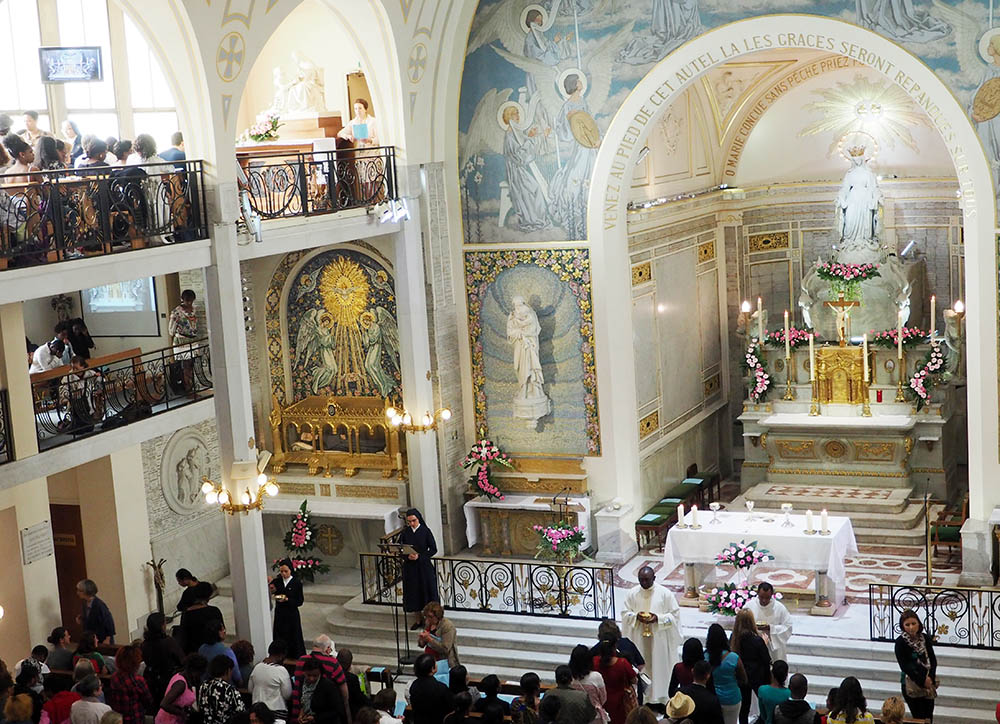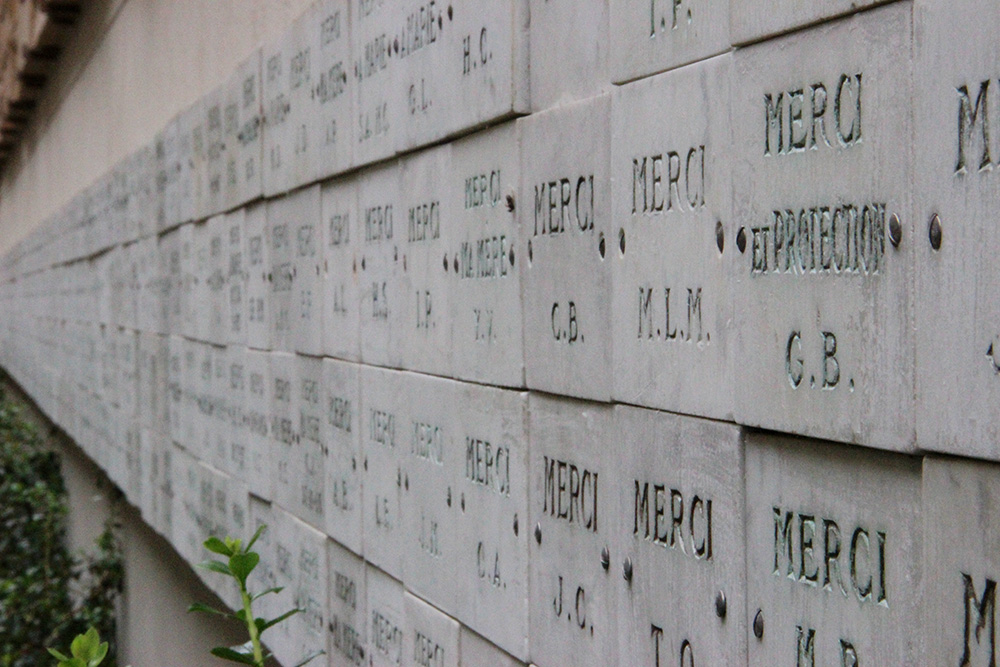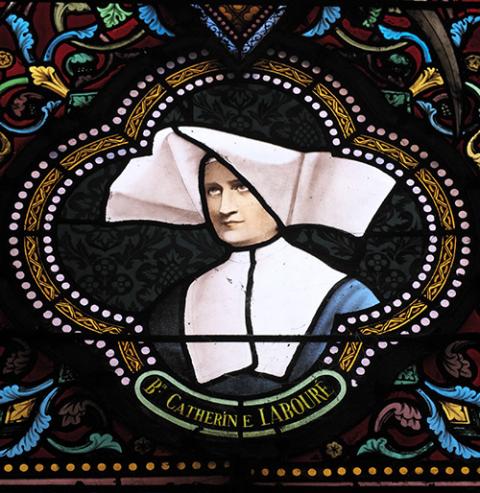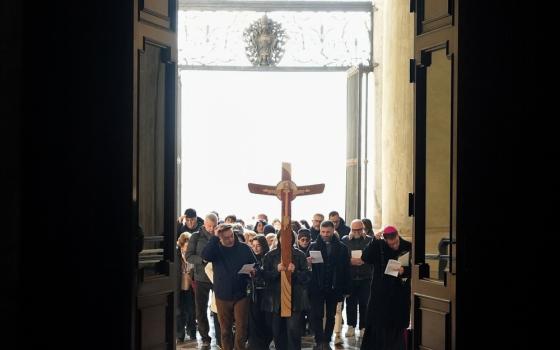
Mass is celebrated at the Chapel of Our Lady of the Miraculous Medal in Paris. Three Masses are celebrated every day, more on Sundays. (Courtesy of the Chapel of the Miraculous Medal)
Editor's note: This is part of an occasional series of stories and columns about Marian shrines and devotions and how Catholic sisters are connected with them.
The entrance to the Chapel of Our Lady of the Miraculous Medal is discreet. A gate located next to one of the most expensive and chic department stores in the heart of Paris opens to a paved way leading to the shrine.
The Chapel of Our Lady of the Miraculous Medal is a place where people come to worship every hour, every day, all year round, from everywhere on the planet.
For more than 150 years, since it was opened to the public, they have come to pray to Mary, the mother of Jesus, sometimes in the hope of a miracle, sometimes to ask for her protection, or simply for a prayer of thanksgiving. About 3 million people visit the shrine every year.
Now that the pandemic has eased, tourists have come back to Paris — and to the shrine. It is easier to get to than other Marian sites such as Lourdes in France. "We welcome organized pilgrimages just about every day," explains Fr. Alexis Cerquera Trujillo, a Lazarist priest from Colombia who has served as chaplain of the shrine since 2019.
The Daughters of Charity welcome the pilgrims, take care of the chapel and help with the distribution of Communion.
Advertisement
Currently, a lot of Brazilians visit the shrine, and more and more Asians, especially Japanese and Korean, come to pray to Mary. Three Masses are celebrated every day, more on Sundays.
Built in 1815, the chapel was dedicated to the Sacred Heart of Jesus. In 1830, a novice of Daughters of Charity, Catherine Labouré, experienced apparitions of Mary and received instructions to have the Miraculous Medal made.
She told her confessor about the apparitions and the medal. He forbade her to speak about it and she obeyed. Two years later, a cholera epidemic swept through Paris. She spoke with her confessor again about the medal, and the Daughters of Charity began distributing the first 2,000 medals. Reports of cures and protection from other diseases began spreading, as did devotion to the Miraculous Medal and the accompanying prayers.

The Miraculous Medal (Courtesy of the Chapel of the Miraculous Medal)
Pilgrims come to the shrine to buy medals, sometimes in large quantities, to give to friends and family. Medals are blessed by the priest at the end of every Mass. The shrine can hold as many as 700 people, as is the case for holidays such as the Assumption of Mary on Aug. 15.
The sisters also have their own private services. Every afternoon the rosary is sung and everyone is welcome.
The chapel is private, owned by the Daughters of Charity. The congregation's headquarters are there, along with other buildings, including the motherhouse. The congregation was founded in 1633 by Sts. Vincent de Paul and Louise de Marillac, whose statues grace the entrance to the building.
Over the years, the company continued its service according to the spirit of the founders: humility, simplicity and charity. There are now about 13,000 Daughters of Charity in 96 countries in all five continents.
Taking care of the chapel is not their only ministry. The sisters continue their work with poor and sick people as they do everywhere.
Sunday Masses are always full. The crowd is diverse. In February and May, a celebration of the anointing of the sick takes place during Mass for those who have asked for it. In most churches in France, this sacrament is offered once every year in February during Mass. Because of a higher number of requests, the Chapel of Our Lady of the Miraculous Medal has had to do it twice a year.
Ceremonies of consecration of children to Our Lady of the Miraculous Medal are held in May and October, with families having to register and prepare for them.
The pandemic hit the shrine, like every site in France. A strict confinement was imposed in 2020, when all churches and chapels were closed for six weeks.

Votive plaques offering thanks are seen along the street outside of the Chapel of Our Lady of the Miraculous Medal in Paris. (Wikimedia Commons/Ketounette)
Every Tuesday, intentions left in the basket in the chapel are presented to Mary during one of the three Eucharists. During the confinement, the number of prayer intentions increased dramatically. People would send them by email on the chapel website.
Many were praying for a cure and healing of the sick, whereas before, there were more prayers from women hoping to get pregnant, from unemployed people to find jobs, as well as other usual intentions.
People can also call a hotline to talk to a priest or ask for prayers. When churches and chapels reopened, the faithful had to keep a safe distance from others.
"Of course, during the pandemic, some people refused to abide by these rules, Cerquera remembers. "A woman assured me that the Virgin Mary had told her she did not need to wash her hands."
Many were obviously praying for sick relatives. "During the pandemic, we saw a lot of people crying in the chapel; more than before" added Sr. Emilia Camarote, a Daughter of Charity from the Philippines who is in charge of the chapel.
The number of people coming for confession also increased with the pandemic.
Most pilgrims buy a medal before leaving the shrine. "It is the most common pious object in the world, " Cerquera said. "We only have them here, not online. People have to come here to get a medal. We are not a business."
The medals come in different sizes, in golden or silver color and are priced low so many people can afford them.
"We do not sell them. We distribute them," insists Cerquera, who says he doesn't know exactly how many are sold every year.
The chaplain says the question pilgrims ask most frequently is "Have there been miracles?"
" 'What do you mean by miracle?' I reply. There have been miracles, of course, but we do not advertise them," Cerquera said.
The Miraculous Medal got its name and reputation in 1832, when Paris was struck by a terrible cholera epidemic that caused at least 20,000 deaths. In June, the Daughters of Charity started distributing little medals picturing Mary.
The epidemic receded, fewer people were infected, and soon Parisians called the medal "miraculous." The name stuck. Many conversions followed.
On Nov. 27, 1830, the Blessed Virgin had appeared to Labouré in the chapel. After a while, an oval formed around the apparition and Labouré could see this invocation: "O Mary conceived without sin, pray for those who have recourse to you"

St. Catherine Labouré is depicted in stained glass at Sacred Heart Church in Moulins, France. (Wikimedia Commons/GFreihalter)
She heard a voice telling her: "Have a medal made according to this mode. For those who wear it with confidence, there will be abundant graces."
The image turned to reveal the reverse side of the medal with the letter M, a little cross and two hearts.
In December 1830, Labouré heard a voice telling her again about the graces people who prayed to Mary would receive and announcing that this was the last message.
By 1835, there were more than 1 million medals worldwide, and in 1839 more than 10 million medals had been distributed. Labouré, who ministered with the poor and elderly for 46 years, was canonized on July 27, 1947, by Pope Pius XII.
At the time of Labouré's death in 1876, there were more than a billion medals in the world. Nobody knows how many are in circulation today, but the Chapel of Our Lady of the Miraculous Medal is certainly famous all over the world.








